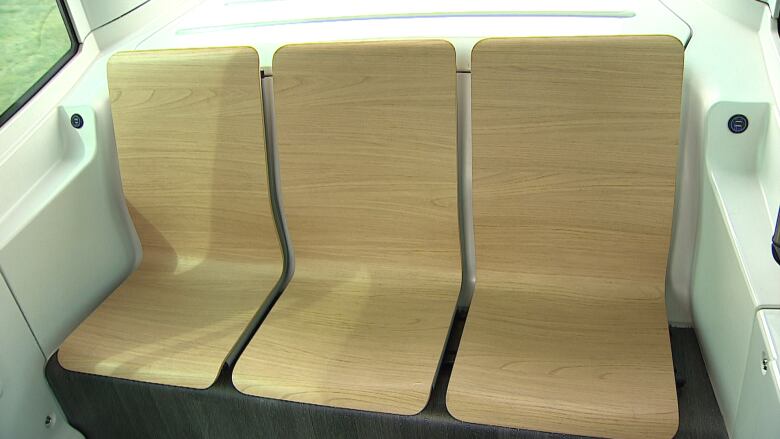You can ride a driverless shuttle for free in Calgary starting Saturday
'Obviously, this is the way of the future,' says Dan Finley of Pacific Western, which is sponsoring the pilot

Calgarians will soon be some of the first people in Western Canada to take a free ride on a public, driverless vehicle.
Calgary's electric autonomous shuttle, dubbedELA, is one of two self-driving shuttles that will be available to the public this month in Canada the other pilot project is running in Quebec.
On Sept. 8, the 12-passenger vehicle will begin transporting peoplebetween the Calgary Zoo and the TelusSpark science centre along a separate roadwayfree of other vehicles, cyclists and pedestrians.
The low-speed ride will take roughly 3 minutes from one side to the other, and it's open to online bookings and walk-ups.

"This is really helping us explore what the future could look like," said Andrew Sedorwith the City of Calgary.
The project is a collaboration involving brains and money from academia, industry and all three levels of government.
"So Canada is somewhat trailing behind when it comes to tests like these, but we're on the fast track," said Sedor.
Information gathered during the one-month pilot program will inform future urban planning decisions and help academics understand how people respond to changing technologies.
"We're going to understand what the public thinks of it, what are some of the other applications, but for now it's just going to be this month-long pilot," said Sedor."Sowe don't have any long-term capital plans where we're actually going to be implementing the technology."
How it works
The driverless vehicle navigates its path using signals it receives from about 20 satellites orbiting Earth. It's similar to how a car's GPS works, but with far greater accuracy.
"We use our high precision technology that navigates to about two centimetres' precision to keep the vehicle on its track," explained Jonathan Auld, vice-president of engineering withHexagon Positioning Intelligence.
The navigation system was built right here in Calgary.
We wanted to sort of show that Calgary has a high tech scene that's, you know, bubbling away and doing really well and we're part of it," said Auld.

To help it avoid obstacles in its path, ELAis equipped with LIDAR,which stands for Light Detection and Ranging.
Pulses of laser light detect objects or people in the vehicle's path. If they come too close, the shuttle stops automatically.
"We're working on transitioning this technology into actual production vehicles for mass production of autonomous vehicles, so that people can spend their time in vehicles being more productive and not necessarily driving," said Auld."And then increase the safety of the traffic flow and the vehicles, since most of the accidents are caused by human error. If you eliminate that you can make driving a lot safer."
While there's no need for a driver, an operator will be stationed on board to help passengers feel at ease with the unfamiliar.
"Any new technology is scary when it first comes online. But humans are adaptive, right?" asked Sedor."If we don't like something, we can say 'No'to it."
How much it costs
The pilot project is expected to run for one month, but it may be extended if it proves popular.
Pacific Western Group of Companies, which is helping to sponsor the project, says it plans to roll out similar pilot projects for British Columbia and Ontario. There is also one launching in Edmonton this fall.
"Obviously, this is the way of the future," said Dan Finley, Pacific Western's vice-president of business development.
"We want to be leading in this space. We want to bring this type of technology into Canada and allow the citizens of Canada to experience this autonomous technology."
The city, which isresponsible for co-ordinating the trial, says the month-long trial is expected to cost Calgary taxpayers $20,000. The project also received $50,000 from Transport Canada, on top of other in-kind donations:
- Pacific Western Transportation (PWT):Procuring, leasing, onsite support and operations of the vehicle.
- ATCO:Providing power to the vehicle.
- Telus:Telecommunication, network services and website development support.
- Michelin:Tire services.
- Big Rig Towing:City and intercity towing and transportation services for ELA.
- Dillon Consulting:Case study on rider behaviour.
- Turbo Images:Vehicle wrap and decals for ELA.
- Corus Entertainment: Promotional support.
- Alberta Traffic Supply:Providing flaggers at cost.
- NovAtel and Infrastructure Mapping & Autonomy: Sponsoring an autonomous vehicle exhibit at the science centre.
- University of Calgary:Multi-departmental research projects.
- Canadian Fibre Optics:Installation of fibre optic cable to enable one of the University of Calgary research projects.
You can ride Western Canada's first public, driverless shuttle for free in Calgary starting Saturday: https://t.co/oYAHqVZ8EC #yyc #yycroads pic.twitter.com/dIA2yVvgdV
—@CBCCalgary- Read more articles byCBC Calgary, like us onFacebookfor updates and subscribe to ourCBC Calgary newsletterfor the day's news at a glance.












_(720p).jpg)


 OFFICIAL HD MUSIC VIDEO.jpg)
.jpg)



























































































